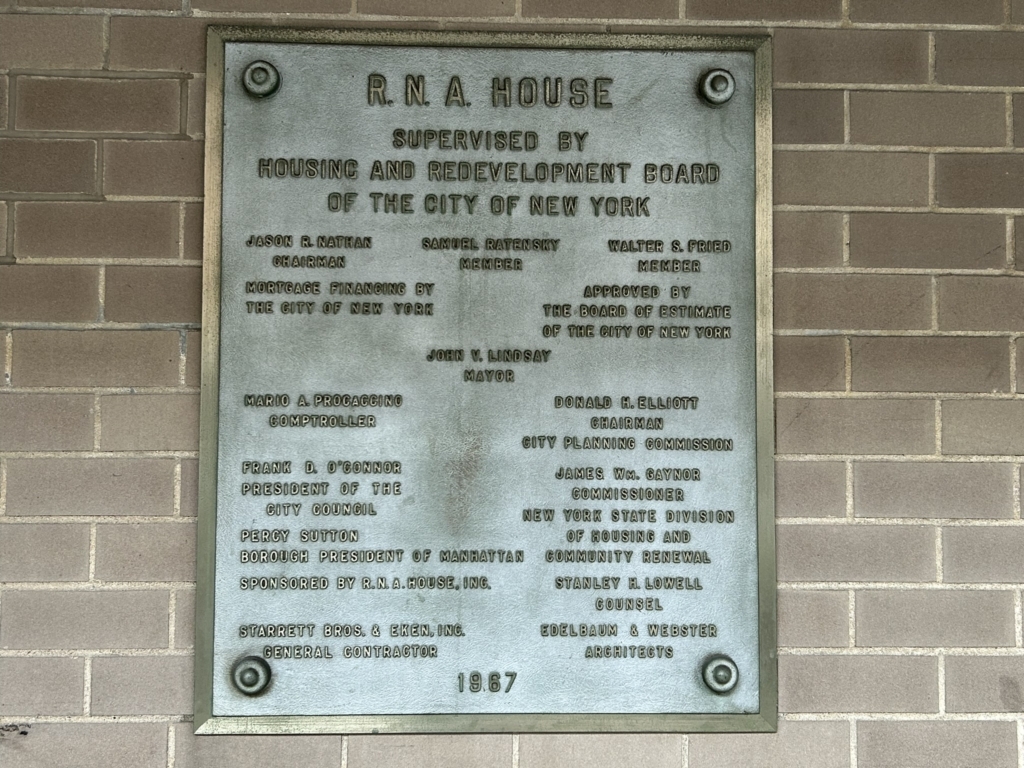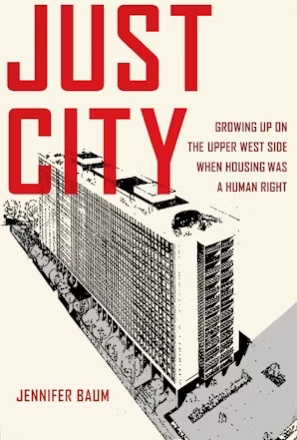
By Ann Cooper
In 1967 four-year-old Jennifer Baum and her family moved into RNA House, a subsidized cooperative apartment building at 150 West 96th Street. RNA House was built under New York state’s Mitchell-Lama Housing Program, created in 1955, at a time “when the idea that housing is a human right was a guiding principle of politics, urban design, and planning,” Baum writes in her new book, Just City: Growing Up on the Upper West Side When Housing Was a Human Right.
Baum’s book is part memoir, part history of public housing programs, and part advocacy appeal for a renewed commitment to programs such as Mitchell-Lama, which enabled her middle class family to buy a three-bedroom apartment with terrace for $3,800, at a time when many other families were fleeing the city for suburbs.
In the decades since Baum grew up, she has moved a number of times, calling Paris, Phoenix, and other cities “home” at various times. But as a writer and filmmaker, she has also remained tethered to RNA House and the Upper West Side, telling stories of life there and of subsidized housing and its role in the community. Baum now lives in Brooklyn’s Ditmas Park neighborhood, but she will be at Book Culture, 536 West 112th Street, Thursday April 4 at 7 p.m., for a conversation about Just City. Details and registration are here.
In an email interview, Baum answered questions about the book from West Side Rag.
WSR: In Just City you share fond memories of the sense of community you felt growing up on the Upper West Side in the 1960s and 1970s. You also share less positive memories, like the strategies you and friends relied on to avoid neighborhood muggers. When you visit the Upper West Side today, what aspects of the neighborhood – good and bad – do you see that have survived from your years growing up here?
Jennifer Baum: There’s still a lot of socio-economic diversity on the Upper West Side thanks to its mix of Mitchell-Lamas and NYCHA housing built as part of the West Side Urban Renewal Area plan, and because of rent control and rent stabilization. But diversity is definitely being threatened by exorbitant rents and asking prices for condos and co-ops. It’s very hard to move to the Upper West Side today unless you have a lot of money. Since the 1990s, a handful of Mitchell-Lama buildings on the UWS have been privatized. People in other Mitchell-Lamas are constantly pushing for privatization, like at RNA House.
There still seems to be a progressive spirit on the UWS. I write in the book about attending the 100th birthday commemoration for St. Gregory’s Church priest Father Henry J. Browne (1919-1980), who led the crusade for affordable housing on the Upper West Side in the ’50s and ’60s. The event was packed with old time lefty politicians like Ruth Messinger and other local housing advocates. That demonstrated to me that the UWS still retains its progressivism.
An RNA House friend mentioned a demonstration at a neighborhood building by the Service Employees International Union, for fair treatment and union coverage of building staff workers. He added that for months after George Floyd was murdered, a group of Upper West Siders gathered at 5 p.m. on Fridays at the 96th Street and Broadway subway entrance to hold a “say their names” vigil. For a few weeks after the murder, some RNA cooperators stood outside the building every night at 7, holding Black Lives Matter signs. Likewise, in Upper West Side apartment and store windows, Black Lives Matter signs and rainbow flags could be spotted. Community social support groups held street fairs, attracted volunteers, and did neighborhood outreach. Activists welcomed homeless people to the Lucerne Hotel, opposing those who fought to have the homeless sent to other neighborhoods.
I’m happy to see there are still independent bookstores and revival cinemas on the UWS, but definitely not as many as when I was growing up. I sorely miss the original Thalia on 95th off Broadway, Lincoln Plaza Cinemas, and the New Yorker, both the theater and the bookstore.
It’s hard to say if anything remains that’s bad about the UWS today. There’s crime, but there’s crime everywhere. All the negative characteristics that marked the UWS when I was growing up were endemic throughout the city, like the polluted air, lack of services, and fiscal crisis.

WSR: In recalling a recent visit to the Upper West Side, you wrote: “I’m not sure I’d want to be a newcomer forming relationships in an overpriced city where only rich people could live comfortably.” Your book focuses on the Upper West Side and New York, but in doing research did you identify other cities that have done a better job of maintaining and expanding affordable housing?
JB: There is a crisis of affordable housing in major cities throughout North America and Europe. When I did research, I discovered that dating back to the 1920s, in the Red Vienna period before fascism, the Social Democrats built 220,000 apartment units, making up about 24 percent of all of the available housing in Vienna. Today in Vienna, over half the population lives in some kind of subsidized housing. And I just read recently in the New York Times about how Paris is financing public housing on a grand scale to ensure that the city remains mixité sociale.
WSR: Your book makes a passionate call for new government investments in programs like Mitchell-Lama that created RNA House. Do you see evidence that there’s a political will – in New York, and at the federal level – to embrace ambitious new affordable housing programs?
JB: Yes, there’s definitely political will, at least in New York. Democrats in the New York State Senate want to bring back Mitchell-Lama housing, dubbing it Mitchell-Lama 2.0. This is very exciting and long overdue. I think this is one great solution to the NYC housing crisis, and I hope it comes to pass.
I don’t know if there is political will at the federal level. I think there is a growing bipartisan recognition that there is a housing crisis in this country. The Biden administration wants to relax zoning laws in order to build more housing. There is an acute housing shortage. We need to build more housing, especially affordable housing, not luxury housing, of which we seem to have an endless abundance.
Just City: Growing Up on the Upper West Side When Housing Was a Human Right, will be published April 2 by Fordham University Press.
Subscribe to West Side Rag’s FREE email newsletter here.











No one can gainsay Ms Baum’s personal history or experiences and we should listen to her story and appreciate her views. We need more affordable housing. However destroying zoning is not the way to do it. Trickle down doesn’t work in real estate anymore than it works in economics generally.,
Lifting height restrictions and destroying zoning will not bring us more affordable housing . Frankly regardless of the claim that affordable housing is the public goal, the real goal, more profit opportunities for developers, explains why this push to destroy zoning is being driven by the same developers and lobbyists who have brought us the Supertalls and the destruction of affordable buildings to bring us street to street units starting at $3million while enjoying tax breaks meant to encourage the building of affordable housing.
City of yes for Housing Opportunity is a con. It will energize and hasten the complete destruction of neighborhoods and communities and supercharge the flight of the working and middle class from the City. It will lead to the destruction of our sense of place and the valued human connections that have sustained us during the bad times. Of course, that is what Adams and his buddies at REBNY want.
Lifting height restrictions and changing zoning will bring us more affordable housing eventually. But it will increase population density. And maybe the neighborhood (already among the most dense housing neighborhoods in the nation) will lose something if we increase the density further.
I think *that* is a fair criticism. But I don’t think we can pretend that the housing market is really magically different than the market for food, oil or other essentials. It just has its own timeline, capital investment cycles, etc. Build lots more housing, and supply will meet demand.
Personally I think we should be upzoning more outer-borough neighborhoods, especially near transit. And building LOTS more transit so that other neighborhoods have the great access and mobility that the UWS has.
Unfortunately, there are a lot of people who tell us what won’t work and then fail to propose any realistic alternative for what will work. The vast majority of housing experts believe that the only way to solve a housing shortage is to build more housing. I think we should do just that on the upper west side and that zoning, height restrictions, historic preservation, and numerous other hurdles are the main barriers to doing so. The City of Yes is a plan to preserve what I value most about our neighborhood – as a place for people to live and work.
Free market works. Not for everybody but for most. Most is good but nirvana is a pride dream. People are people. They’re not fungible. We’re different.
Your post is heavy on opinions with no supporting evidence. Jennifer has done a lot of research on the topic for her book and acknowledges we need to build more and loosen zoning.
The existing zoning is a mess, the ‘supertalls’ are a result of the existing zoning! Many beautiful buildings on the UWS would be illegal to build today because of the FAR cap.
It’s basic supply and demand we need to build more housing otherwise teachers, nurses and other middle income families will continue to get pushed out. Experts agree!
“It’s very hard to move to the Upper West Side today unless you have a lot of money. ”
Hint: Don’t move to the Upper West Side, if that’s the case. It’s quite literally 0.00006% of the U.S. mainland.
The obsession of grown-up adults with “lefty” policies and politicians, “democratic socialism” and similar nonsense is endearing and ultimately… very sad. It speaks of people who’ve never experienced or fully understood what “socialism” really does to the fabric of society.
I grew up in RNA House with Jennie. It was a healthy, happy and very diverse environment in which to be raised. Enabled me to be a school teacher with a low salary, raise my own family there , not get priced-out of the neighborhood, etc.-
Does a new-generation low-salary teacher live in your unit today, or are you now, in your older, less productive age, sitting on a multi-million-dollar asset subsidized in the past by taxpayers…while that same teacher is actually the one priced out of the neighborhood?
RNA is still subsidized so there is not multi-million dollar asset. If people who currently live there make more money in later years, they pay a surcharge, which helps to maintain the building and allows others to be subsidized. One of the problems with NYCHA housing for low-income people, is that it penalizes those who earn too much, disincentivizing them to make more money.
Mitchell-Lama permits people to thrive and stay in their apartments, a good thing as it promotes community and stability. More of these buildings should be built.
This is a valid question as comment but do you want to force Gina out or into assisted living? People are living longer and -unfortunately creating some housing problems. Stopping these developers of endless luxury buildings is a real opportunity; who will live in them? That is a real question. pied-a-terres for the wealthy from elsewhere, investment opportunities for foreigners? Has anyone investigated who buys and who lives in these buildings? With such information, perhaps a rational approach could be created.
The Vienna model that Jennifer Baum endorses does provide high quality, low cost housing. However, it is not without its controversies.
This housing is heavily subsidized by Austrian taxpayers. So an Austrian living in a poor suburban or rural area – or within Vienna itself but not in one of these subsidized housing units – is paying for these subsidized apartments with higher taxes.
Furthermore, it is actually quite difficult to move into one of these subsidized units as people who have them rarely leave and these units are passed from generation to generation.
Obviously, not every Austrian is happy about this setup.
This is similar to NYC where folks living in rent regulated or Mitchell- Lama or public housing or any other allegedly “affordable” housing unit is being subsidized by people who don’t have these entitlements.
Economics is all about trade-offs. If one person benefits from an entitlement someone else is paying the tab. The solutions Ms. Baum proposes to solve our housing problems are like pouring gasoline on a fire to put it out.
Vienna’s net population fell 35% from the 1930s until they allowed private developers to build new buildings outside of rent controls. It’s a terrible example.
You are 100% correct. How did people get into Mitchell lama apartments back in the day? Block fairs recruiting people to move into the neighborhood. Half of the neighborhood were burnt out townhouses. The city ended up buying those. Also, Mitchell Lama is income based not asset based. Very few people ever give up these apartments because why would you? If the city were smart, they could offer people money to move out and it would be a lot cheaper than building new housing.
It is easy to live on the UWS, there are always rooms for rent in the public housing developments. No one ever “tests out” of qualifying no matter how many jobs they hold and salaries they collect and subsidized programs in which they are enrolled – it just means they can buy bigger cars and tv’s and complain about a lack of “rights.” That, plus the city’s inability to manage and maintain public housing is not reason to do anything except clean up the act.
Builders will not build anything unless they can make a profit. People have to realize this.
Housing shouldn’t be built solely for profit.
like iPhones, groceries, and automobiles?
Nor should housing be an entitlement-asset, passed generation to generation, while younger generations of newly-arrived middle-class and working-class teachers, firefighters, EMS employees, and police officers struggle to find a place to live.
Before another dime of taxpayer money is spent on ‘affordable housing’:
1) Eliminate rent controlled apartments altogether.
2) Eliminate inheritance of rent controlled apartments.
3) Limit rent-stabilized leases to 20 years total.
4) Make rent-stabilized leases subject to annual asset- and income-verification.
Just start with these measures. Give the market 5-10 years to shake out. THEN re-evalulate the affordable housing market, and plan accordingly.
Frankly, I find the notion that ‘Housing is a human right.’ as absurd as it is repugnant.
Big talkers like the entitlement-class author of this nonsense-book should be required to put THEIR money where their mouth is.
Parasites, one and all.
This article isn’t about rent control; it’s about Mitchell-Lamas. So I’m unsure how your comment is relevant here.
Either way, blaming other low-income people for the fact that you are priced out of the housing market (calling them “parasites,” no less) shows me that you’re not exactly inclined towards rational conversation.
Please stop parroting the myth that only “low income” people live in rent regulated and Mitchell-Lama apartments.
There are many wealthy people who reside in these apartments. In fact, they often became wealthy by saving because they have lived decades paying a pittance in rent.
If anything, “low income” people lack the connections to get these apartments.
Another hostel comment without regard to people’s age, health, and the suggestion that a home should not be viewed as a home but as a lay-over.
So you suggest when somebody’s burned out they should be thrown out?
Reading some of the inhumanity in this column is discouraging and depressing.
No wonder there’s so much hatred and lack of compassion in the world.
I hadn’t heard about Father Browne until I read his son Harry’s application for a study abroad scholarship. In his essay, he wrote about being the son of a Catholic priest who was leading a double life, by being married and having children while serving as a priest. At the time, 1984, this seemed a tad shocking. but apparently many in the neighborhood knew about it but kept it quiet because he was so beloved for all he did to help the community. He was a maverick in more ways than one. A street is named after him and his memory is still being honored years after his passing. Thanks for reminding us about him.
I love how people are nostalgic about a time and set of policies that led to New York’s bankruptcy, an enormous rise in crime, the deterioration of schools, and a UWS where kids were always on alert from muggers. But sure, let’s follow the same principles. And by the way, the Mitchell Lama project she grew up in was possible because they tore down 16 houses on 96th Street through eminent domain. But sure…keep believing.
In retrospect the UWS in the 1970s might have had a kind of gritty charm but it was also dirty and dangerous and in decline. I was only a young child at the time but I remember the UWS as a scary place. Nobody in their right mind looks at this era as something we should aspire to be like again.
People often look thru the past with rose colored lenses. The UWS in the 1970s wasn’t exactly Mayberry. She is nostalgic for a past that never existed.
The entire city (every major urban area in the US, in fact) was going through a period of high crime in the 1970s – early 1990s, due to factors that have absolutely nothing to do with building affordable housing on the UWS. You’re trying to make a causal connection where none exists. Might as well say there was a rise in crime because of the Cola wars between Pepsi and Coke.
I grew up on the UWS in the 80s – early 1990s and it was not a “scary place.” Yes there was more crime than there is today, but it was hardly the war zone you’re trying to paint it as. You just didn’t walk around late at night, and there were certain blocks that were off-limits. But we still took leisurely strolls through the neighborhood, shopped at the local shops, played in the parks and neighborhood playgrounds, took classes and did activities at the local theaters, churches, museums, libraries, community gardens, etc. You’re acting like people walked around scared all the time, and that’s just not accurate. You just had to be aware of your surroundings, which is good advice even when crime is low.
It was the same vibrant neighborhood it’s always been; it was just rougher during those ~20 years. And this sense of community, where most of your life takes place within your neighborhood, can’t happen when a neighborhood is populated almost exclusively by rich transients who don’t care about each other or the welfare of their community because they live there only 2 weeks a year, or are just planning on flipping their apartment in 5 years.
On a lighter note, there is another memoir written by someone who grew up in that building. It is funny and entertaining and gives a good feel of what life there was like in the late 60’s and 70’s. Frank McCourt was her English teacher. Hypocrite in a Pouffy White Dress by Susan Jane Gilman